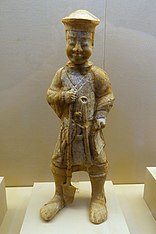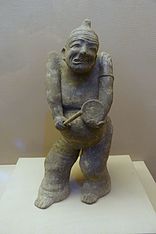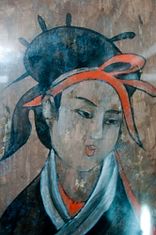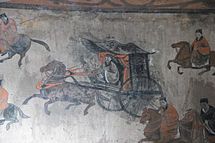Society and culture of the Han dynasty
| Chinese ceramic figurines of the Eastern Han (25-220 CE) period, exhibits from the Sichuan Provincial Museum, Chengdu, Sichuan, China | |||||
|---|---|---|---|---|---|
|
|||||
| Murals of the (Chinese: 打虎亭汉墓, Pinyin: Dahuting Han mu) of the late Eastern Han Dynasty (25-220 CE), located in Zhengzhou, Henan province, China, showing scenes of daily life. | |||||||
|---|---|---|---|---|---|---|---|
|
|||||||
The Han dynasty (206 BCE – 220 CE) was a period of ancient China divided into the Western Han (206 BCE – 9 CE) and Eastern Han (25–220 CE) periods, when the capital cities were located at Chang'an and Luoyang, respectively. It was founded by Emperor Gaozu of Han and briefly interrupted by the regime of Wang Mang (r. 9–23 CE) who usurped the throne from a child Han emperor.
The Han dynasty was an age of great economic, technological, cultural, and social progress in China. Its society was governed by an emperor who shared power with an official bureaucracy and semi-feudal nobility. Its laws, customs, literature, and education were largely guided by the philosophy and ethical system of Confucianism, yet the influence of Legalism and Daoism (from the previous Zhou dynasty) could still be seen. Members of the scholarly-gentry class who aspired to hold public office were required to receive a Confucian-based education. A new synthetic ideology of Han Confucianism was created when the scholar Dong Zhongshu (179–104 BCE) united the Confucian canon allegedly edited by Kongzi, or Confucius (551–479 BCE), with cosmological cycles of yin and yang and the Chinese five elements.
...
Wikipedia










